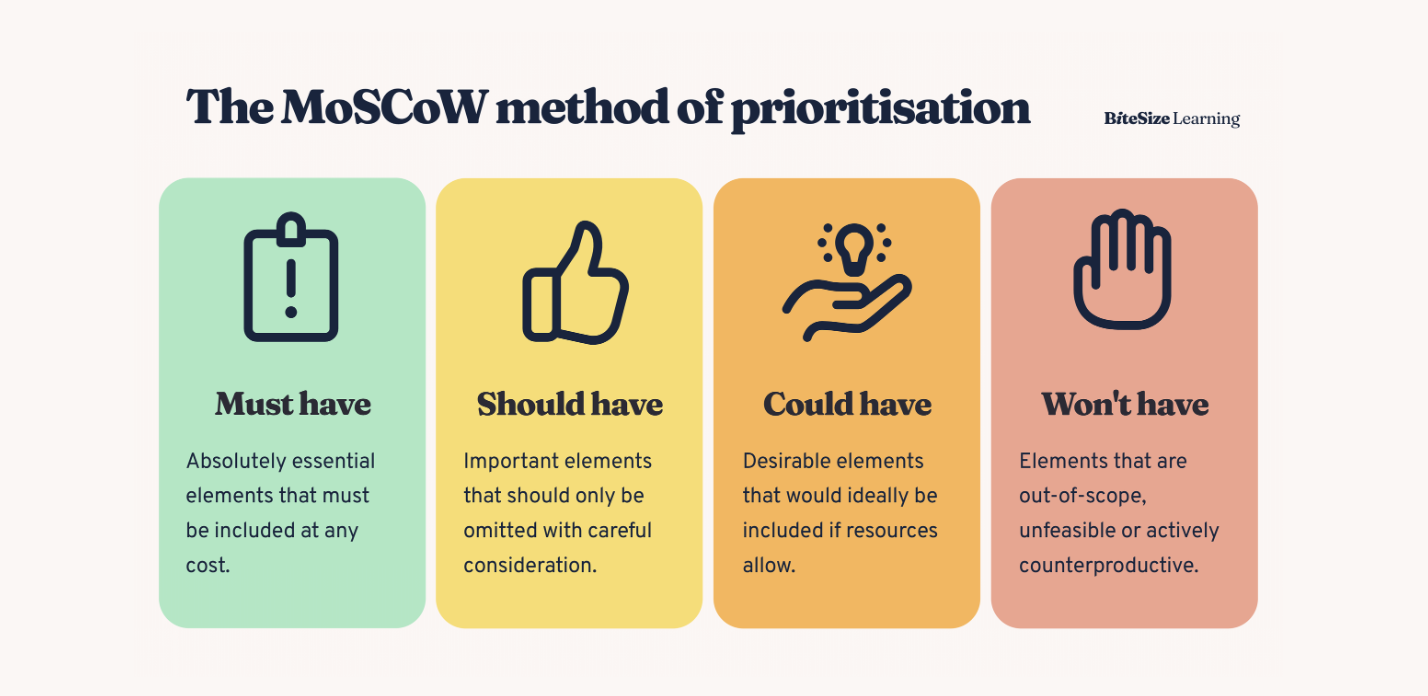Big Hairy Audacious Goals, explained
What Does BHAG Stand For?
BHAG is an acronym that stands for Big Hairy Audacious Goal – a colossal and transformative objective that influences every part of an organisation.
These towering targets aren’t merely about ‘aiming high’ – these are the ultimate, company-wide stretch goal, requiring seemingly impossible feats that challenge the status quo and redefine what’s considered achievable.
Feel free to include our Big Hairy Audacious goal picture in your own worksheet or PPT - just add a link to BiteSize Learning.
So what is a Big Hairy Audacious Goal?
A Big Hairy Audacious Goal is always hugely ambitious. Unlike smaller and less-hairy goals, BHAGs feel provocative – some sceptics will question if they’re even possible.
Similar to a corporate mission or vision, they serve to align an entire organisation in a single direction, but because they’re so epic in scope, they endure for longer than tactical annual or quarterly goals – perhaps even taking a decade to achieve.
However, unlike bland mission statements, big hairy audacious goals tend to be SMART goals, which is to say more tangible, actionable and concrete.
Examples of big hairy audacious goals
Put a man on the moon by EOY 1969
Win the most gold medals in the next Summer Olympics
Be the most-read website in the UK
Create the world’s first fusion power plant
Record a number 1 single
Cure leukemia
Reduce humanity’s carbon emissions to net zero
You get the idea: they’re not ‘modest’, or grounded in a simple multiple of today, (e.g: ‘grow 25%’, ‘improve Net Promoter Score to +60’). Instead, a Big Hairy Audacious Goal has the swagger to ask: ‘Why shouldn’t we be #1?’
Ambitious as these goals are, however, they’re still specific – it’s easy to understand what achieving the goal would look like, and immediately start thinking about what it would take to get there. As the originator of the term observes: they ‘have a clear finish line… people like to shoot for finish lines.’
Conversely, a broad mission statement like Starbucks’ – ‘nurture the limitless possibilities of human connection’ – might sound ‘big’, but it’s in not an actual goal. Ordinary people would struggle to break this down into practical steps – and it would be impossible to tell the mission had been accomplished.
A leader can’t motivate a team with ‘listen up folks, we’ve only got three months until the big day when we’re meant to be nurturing the limitless possibilities of human connection, so we really need to push!’
Who coined the term ‘Big Hairy Audacious Goal’?
‘Big Hairy Audacious Goal’ was coined by Jim Collins and Jerry Porras in their classic work, “Built to Last: Successful Habits of Visionary Companies.” The book, a result of rigorous research into what makes visionary companies tick, described BHAGs as a hallmark of firms that achieve extraordinary long-term success. Collins and Porras argued that these audacious goals are key to cultivating a corporate culture of ambition and relentless progress.
The benefits of setting Big Hairy Audacious Goals
Inspires action: The epic scope of the goal makes it clear what’s expected, and encourages everyone to push beyond their pre-conceived limits.
Counteracts status-quo bias: Typically, we compare ‘changes’ to how things are today, and so tend to avoid large changes from the status quo. But the BHAG provides a new benchmark for assessing work: not ‘is this a bit better than today?’ but ‘is this enough to get us to the goal?’ It provokes more radicalism and less incrementalism.
Sharpens focus: The objective is so daunting, that it will clearly be impossible – unless 100% of energy is directed purely towards achieving it. Everything can be sharply prioritised in terms of how it ultimately contributes to achieving the goal.
Demands innovation: The audacious nature of a BHAG necessitates innovative thinking – it’s not just a small step forward, it will require pushing individuals and teams to explore new territories and solutions.
Fail better: as the saying goes, shoot for the moon, and even if you fail, you’ll still end up among the stars. (It’s worth considering if this applies in your situation, or if you might instead end up in the cold, endless void of deep space.)
Who can use big hairy audacious goals?
Scenarios that are a great fit for BHAGs include…
Growth – BHAGs can help growth-oriented organisations define how fast and far they want to expand
Challengers – Being #1 at something makes an exciting BHAG – staying at #1 is a bit more pedestrian
Disrupted organisations that need to radically change direction in order to survive
Mission-driven organisations, such as charities and public sector organisations, working towards a well-defined outcome
Organisations that might benefit less are:
Explorer teams that are still figuring out the right direction to go in
Portfolio organisations that prefer to spread effort across a range of strategic bets
Defensive incumbents who may be more focused on doing more of the same and making gradual optimisations
Steady-state or functional teams where extreme improvements and hypergrowth aren’t relevant metrics
Heavily constrained teams that lack the resources to commit to big moves
Making big hairy audacious goals work for you
When embarking on the journey to define your or your organisation's BHAG, you’ll need to ensure:
it aligns with your core values and long-term vision
it’s clear enough to guide decision-making, but flexible enough to adapt to changing circumstances.
you’ve engaged with all stakeholders in its formulation to ensure buy-in and collective ambition.
Ultimately, this is a simple but powerful tool for charting a daring course forward. It can be a provocative jumping-off point during a creative problem solving process, encouraging participants to think much, much bigger than they do usually.
That said, this is far from the only approach worth considering.
If you’ve gotten a tad unfit, for example, it’s perfectly reasonable to set a short-term goal – perhaps following a Couch to 5k programme for ten weeks – and seeing how you get on, before setting another goal based on your progress thus far.
Alternatively, you might make a simple process-based commitment you can fulfil flexibly – putting to one side other metrics like speed and distance – like working out for 6 x 30 minute blocks a week, rain or shine. This is all about developing habits that naturally take you in the right direction.
Conversely, the ‘Big Hairy Audacious Goal’ concept might invite you to ask more challenging questions, like:
OK, but what if you had to run an ultramarathon?
For a billion dollars, to save the world, whatever hypothetical you like – could you get to the required level of fitness? In two years? In one? How have other people like you accomplished this? Could you find out? What other lifestyle changes would you need to make?
If you can admit that, while ‘obviously laughable’ and ‘totally unrealistic’, it’s also not technically impossible… then you’re in the scary, thrilling Realm of the BHAG.
For some people, that’s a deeply motivating place to be, and the excitement of going ‘all-in’ on such an audacious goal provides its own irresistible momentum.
But for others, the Bigness of the BHAG might feel burdensome, or even a distraction from the simple work of putting one’s trainers on and getting the steps in.
Related links
SMART goals and why they help you get things done
The ‘Built to Last’ book on Amazon UK








